Cure your winter blues with a steamy pot of Japanese Kimchi Nabe. Made with anchovy broth, kimchi, pork belly, and vegetables, this soup pot is hot and sour with a good kick of spice that warms you right up!
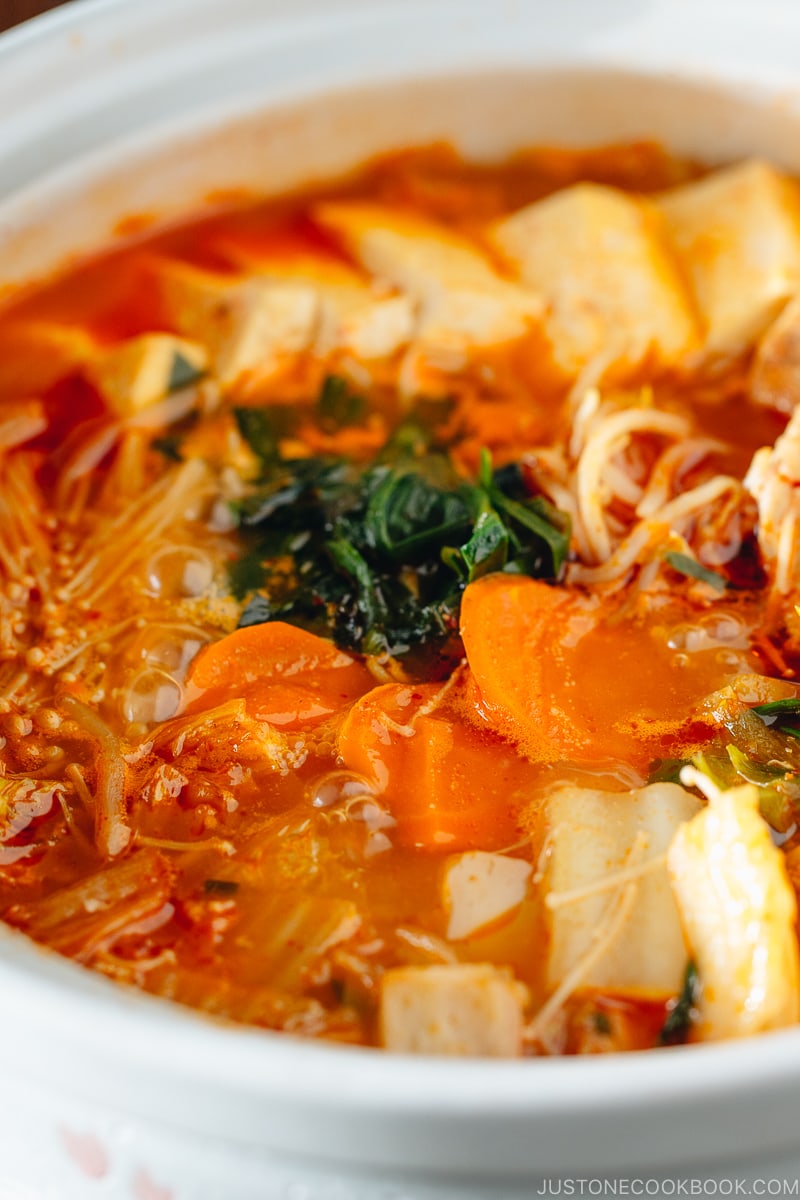
As cold weather continues in most of the Northern hemisphere, I’d like to share another Japanese hot pot recipe with you.
Today we’re cooking Kimchi Nabe (キムチ鍋). Back in the early 2000s, Japanese TV stations started to broadcast Korean drama series. At that time the Japanese were exposed to more Korean foods that were relatively new to them. One of the Korean dishes that became popular in Japan was Kimchi Jjigae, Korean Stew.
Japanese started to make their version at home and in restaurants and called it Jjigae Nabe (チゲ鍋). Then they learned that Jjigae and Nabe have similar meanings and that the word “Jjigae” in Japanese implies spicy Korean food. So these days people call it Kimchi Nabe.
Now you are probably wondering if Kimchi Nabe is the same as Kimchi Jjigae, or how different they are. So let’s get started.
Kimchi Jjigae vs. Kimchi Nabe
First thing first. Are they the same or different? The quick answer is yes and no.
Kimchi Jjigae was introduced to Japan but after some time, the Japanese people adjusted the flavors to their liking (less spicy) and added more vegetables to this dish that are not used in Kimchi Jjigae. Also, the Japanese use a big donabe for this dish and treat it like a nabe (hot pot) instead of a single serving Korean stew.
As a result, this dish is no longer authentic Kimchi Jjigae anymore. So yes, it’s similar but not authentic enough to call Kimchi Jjigae.
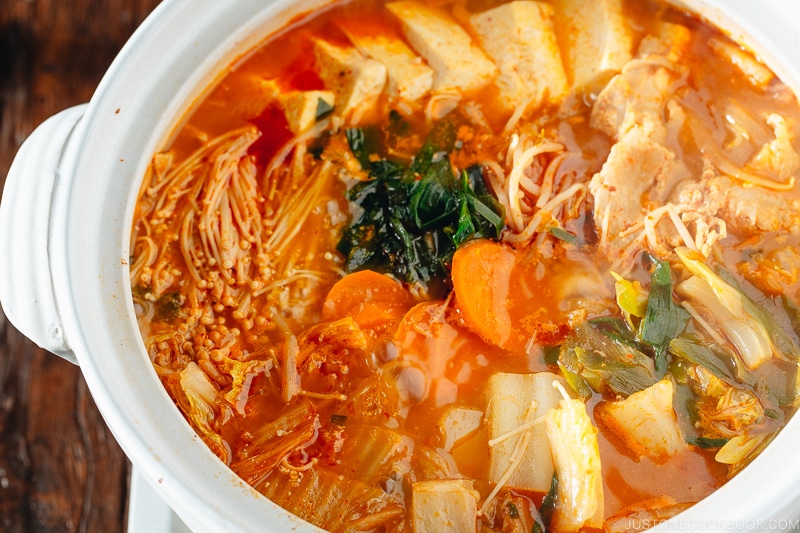
So… How did the Japanese adopt Kimchi Jjigae?
Each household makes this dish differently, but here are some of the “general” changes that I could think of:
Ingredients
- Just like other hot pot dishes, napa cabbage leaves are added to Kimchi Nabe in addition to kimchi. Kimchi Jjigae includes napa cabbage kimchi but does not include raw napa cabbage leaves.
- Typical hot pot ingredients are added to Kimchi Nabe, including napa cabbage, enoki mushrooms, Negi (long green onion), shiitake mushrooms, carrots, shirataki noodles, deep-fried tofu, and other hot pot ingredients.
- One thing that Kimchi Nabe does not usually include, but Kimchi Jjigae sometimes includes is an onion. Onion is not a common vegetable to add to a Japanese hot pot (but we do put green onion or long green onion (Negi).
- For the majority of Kimchi Nabe enjoyed in Japan, (Japanese) miso is added to the broth for more savory umami flavors and less intense spiciness.
- At the end of the meal (we call Shime, 〆), Japanese people like to put rice or udon noodles (sometimes ramen/Chanpon noodles) in Kimchi Nabe.
Cooking Method
- To make Kimchi Jjigae, aged kimchi is used and it’s cooked with meat first to remove some pungency before adding broth. The Japanese kimchi sold in Japan is not as pungent and spicy as one in Korea; therefore, kimchi is often added directly to the broth of Kimchi Nabe.
- Ingredients are added to Kimchi Nabe in an organized way so that each ingredient stays in one location (think of a slice of pie) and avoids mixing up with other ingredients.
How To Serve
- Unlike Kimchi Jjigae that is served in a single pot, Kimchi Nabe is cooked in a large donabe, Japanese earthenware pot, and served at the table.
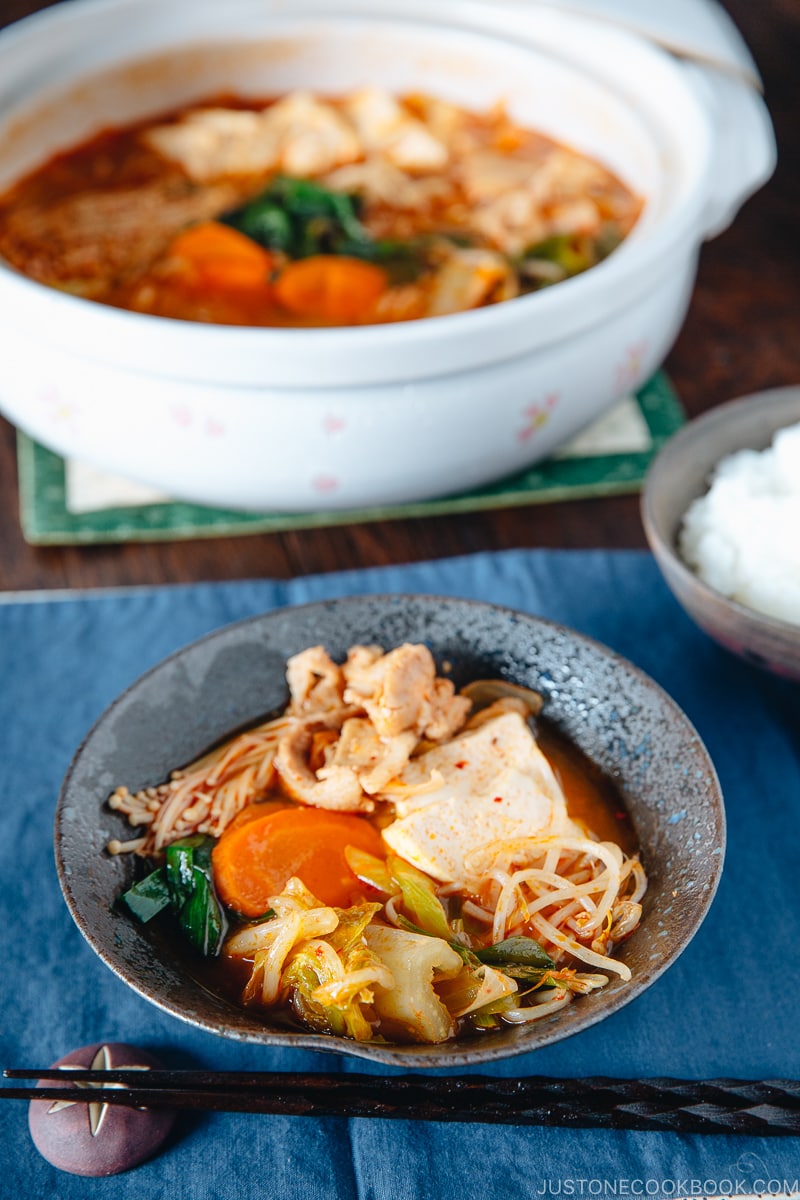
My Kimchi Nabe
I received quite a number of requests for the Kimchi Nabe recipe from my readers so I hope you like my version.
As I live in the U.S., and I’m more exposed to Korean foods, I decided to implement the Korean approach and cooked meat, kimchi and onion first. I use Korean kimchi instead of Japanese kimchi made in Japan, so I believe this method works best for my Kimchi Nabe.
Then I seasoned and added soup stock. Speaking of stock, I could have made it with typical Japanese dashi made of kombu and katsuobushi (bonito flakes). However, to make it a tiny bit closer to the original Kimchi Jjigae flavor, I used iriko (dried baby sardines/anchovies) and kombu. You could substitute with chicken broth as well, but I really encourage you to make your own broth with kombu and anchovies (or even bonito flakes).
If you don’t eat spicy food, reduce the amount of kimchi, gochujang, and gochugaru. The soup has good flavor from dashi already so removing the amount of spice won’t affect the final result too much.
Premade Nabe Soup Stock
Some people asked about premade nabe soup stock that is sold in Japanese grocery stores including Kimchi Nabe and Yosenabe, or Chanko Nabe. Those premade soup stocks seem convenient as all you need to do is to pour the soup broth into your pot and add fresh ingredients to it.
However, they include preservatives, MSGs, and unknown ingredients that I can’t pronounce if you look at the ingredients on the back. I highly recommend and encourage you to make your own nabe soup broth. If you make the soup stock (dashi) the previous day or before going to work, it’s really easy to put it together when you are ready to eat.
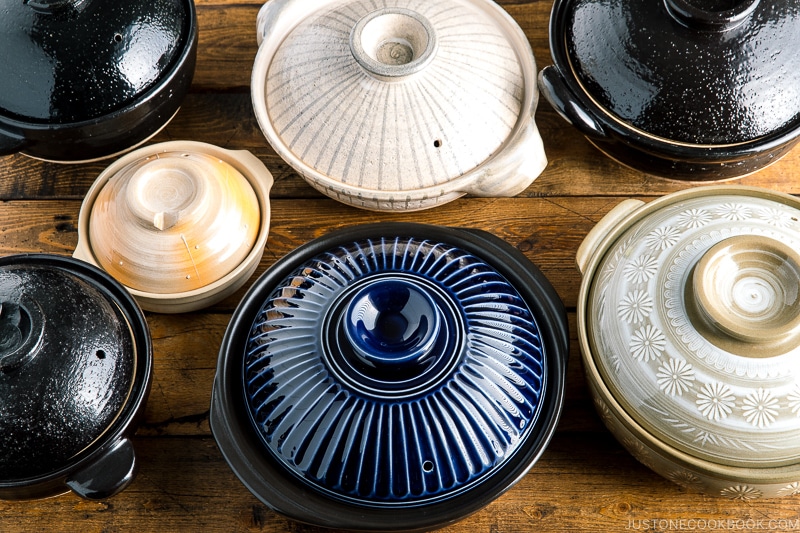
How to Season Your Donabe
By the way, if you have a donabe earthenware pot and don’t know how to season or take good care of it, I recommend checking out this post.
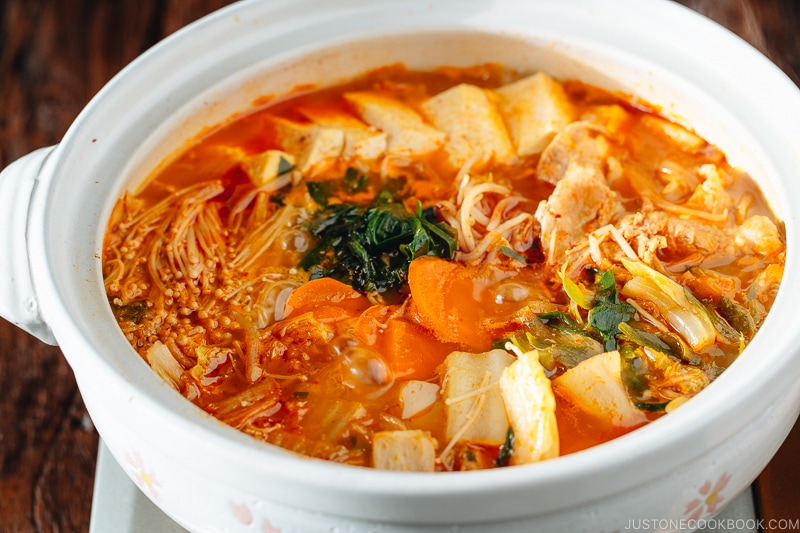
Wish to learn more about Japanese cooking? Sign up for our free newsletter to receive cooking tips & recipe updates! And stay in touch with me on Facebook, Pinterest, YouTube, and Instagram.
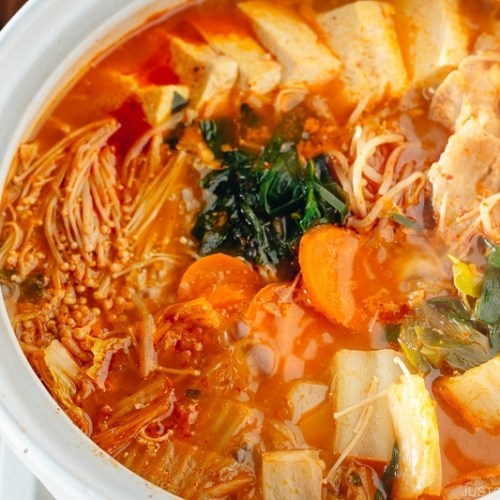
Kimchi Nabe
Video
Ingredients
- 1 lb kimchi (cut if necessary)
- ½ onion
- 14 oz medium-firm tofu (momen dofu) (1 pack)
- 6 leaves napa cabbage
- 1 Tokyo negi (naga negi; long green onion) (or 3 green onions/scallions)
- ⅓ carrot
- 3 stalks garlic chives (Chinese chives or Nira)
- 7 oz enoki mushrooms (1 pack)
- 6 oz bean sprouts
- 13 oz sliced pork belly (or use thinly sliced pork loin. If you can‘t get pre-sliced meat, you can freeze a block of meat for 30–60 minutes and slice thinly. See my tutorial here.)
- 1 Tbsp toasted sesame oil
- 4 cups dashi (Japanese soup stock) (see recipe below; or use chicken broth)
For the Dashi
- ¼ cup iriko/niboshi (boiled and dried anchovies)
- ⅓ oz kombu (dried kelp) (about 3 x 4 inches, 7.6 x 10 cm per ⅓ oz)
- 4 cups water
For the Seasonings
- 1 Tbsp sake
- 1 Tbsp gochujang (Korean chili paste)
- 1 tsp gochugaru (Korean pepper flakes)
- 1 Tbsp sugar
- 4 Tbsp kimchi juice
- 1 Tbsp soy sauce
- 1 Tbsp miso (you can use any type of miso)
- ½ tsp Diamond Crystal kosher salt
Instructions
- Gather all the ingredients.

To Make the Dashi
- This is an extra step and not everyone follows this method, but I highly recommend removing the head and guts from the anchovies to reduce the bitter flavor in dashi (watch how I do it in this video).

- Gently clean ⅓ oz kombu (dried kelp) with a damp cloth (but don‘t wipe off the white powder—that‘s umami!) In a small saucepan, put 4 cups water, the kombu, and ¼ cup iriko/niboshi (boiled and dried anchovies).

- Bring it to boil on low heat. It’s best to slowly infuse the water with the kombu and anchovies. Once boiling, cover and keep on low heat and simmer for 10 minutes.

- Once you are done simmering the dashi, strain through a fine sieve. Set aside the dashi. Tip: With the spent kombu and anchovies, you can make candied anchovies and simmered kombu.

To Prepare the Ingredients
- Meanwhile, start prepping the ingredients. Thinly slice ½ onion. Cut 14 oz medium-firm tofu (momen dofu) into small blocks.

- Cut 6 leaves napa cabbage into 2-inch (5-cm) pieces widthwise (start cutting from the bottom toward the leafy side). The bottom part of napa cabbage is thicker, so cut these pieces into smaller pieces lengthwise (see how I do it in the video).

- Slice 1 Tokyo negi (naga negi; long green onion) diagonally into ½-inch (1.3-cm) pieces and slice ⅓ carrot diagonally into ¼-inch (0.6-mm) slices.

- Cut 3 stalks garlic chives (Chinese chives or Nira) into 2-inch (5-cm) pieces. Discard the bottom of 7 oz enoki mushrooms and loosen them up.

- Rinse 6 oz bean sprouts and place all the vegetable ingredients on a plate. Cut 13 oz sliced pork belly into 2-inch (5-cm) pieces and set aside.

To Make the Kimchi Nabe
- In a large donabe (4–5 serving) or pot (use two donabe or pots if doubling the recipe), heat 1 Tbsp toasted sesame oil over medium-low heat and add the sliced pork belly. Stir-fry the meat until no longer pink.

- Add 1 lb kimchi and onion and stir-fry for 5 minutes.

- Then add 1 Tbsp sake and 1 Tbsp gochujang (Korean chili paste).

- Add 1 tsp gochugaru (Korean pepper flakes) and 1 Tbsp sugar and mix it all together.

- Add 4 Tbsp kimchi juice and 4 cups dashi (Japanese soup stock) and make sure it’s mixed evenly.

- Cover and bring to boil. Once boiling, reduce heat to low and cook for 5 minutes.

- Add 1 Tbsp soy sauce and 1 Tbsp miso. Mix all together and make sure the miso is completely dissolved.

- Add the rest of ingredients and cover to cook on medium heat for 10 minutes, or until all the ingredients are tender.

- Taste the soup and add ½ tsp Diamond Crystal kosher salt if necessary (I added about ½ tsp). Each miso has different saltiness, so you really need to taste the soup to adjust the flavor.

To Store
- You can keep the leftovers in an airtight container and store in the refrigerator for 3 days.
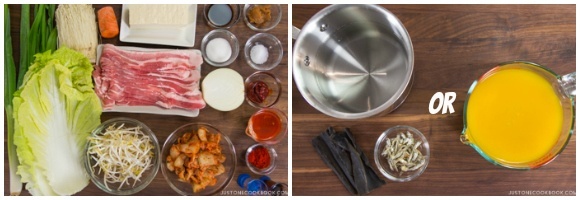
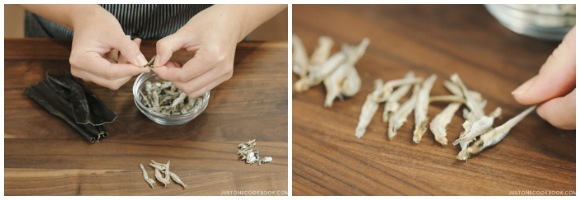
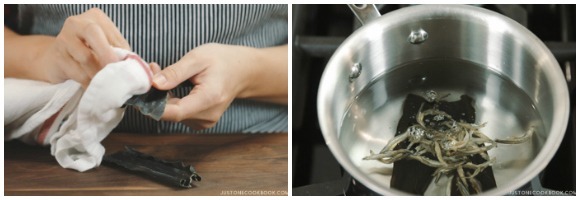
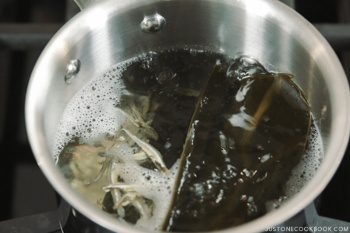
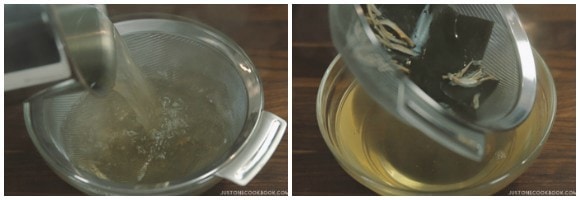
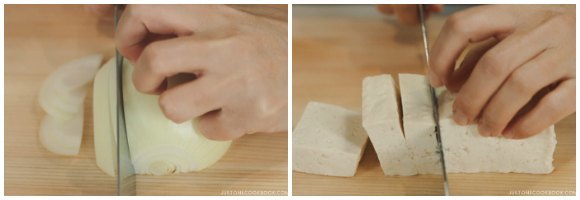
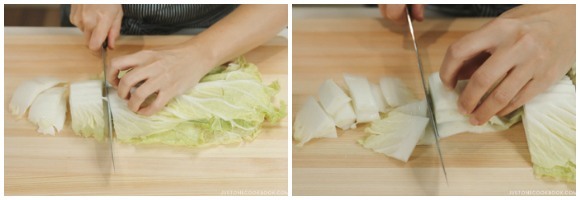
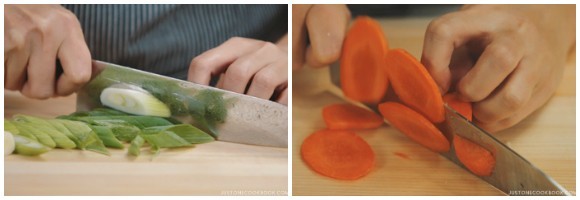
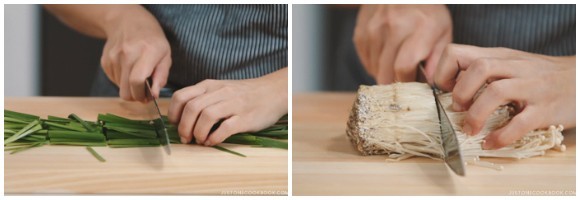
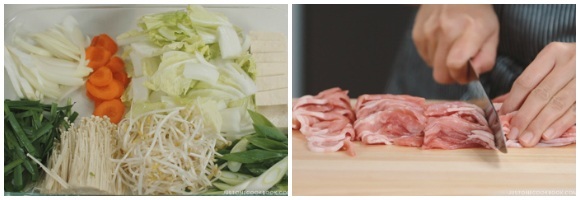
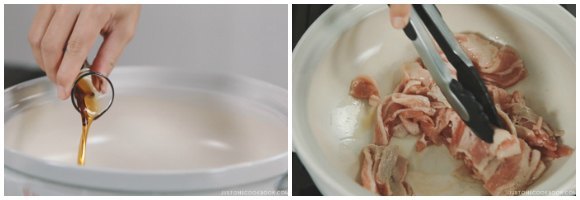
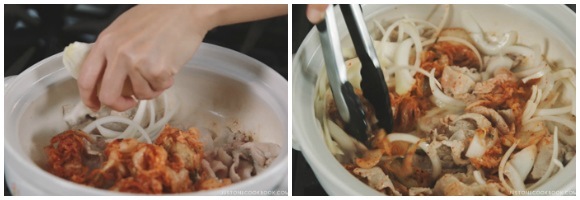
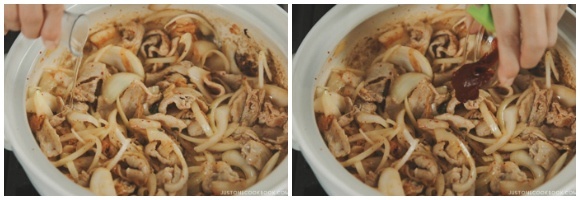
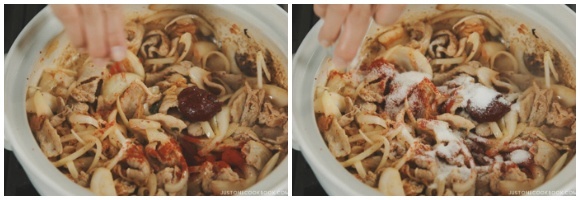
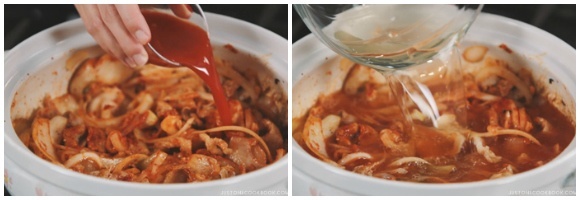
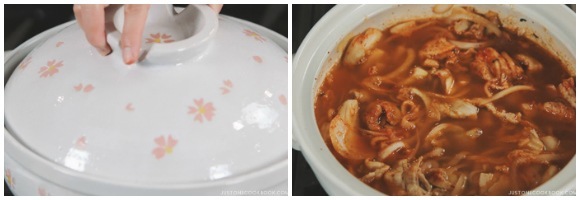
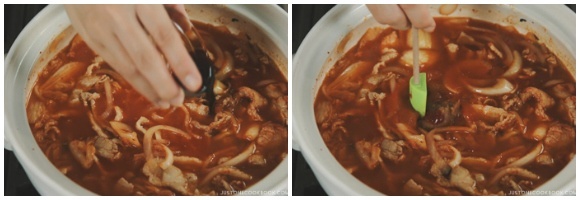
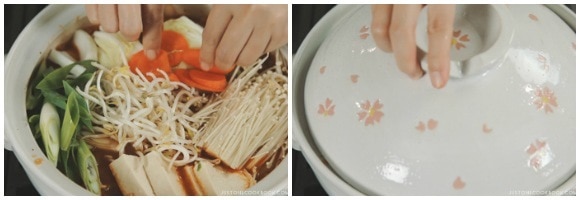
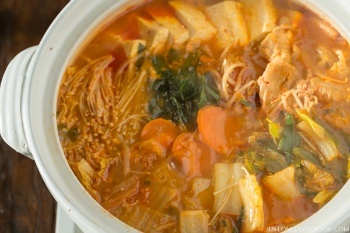

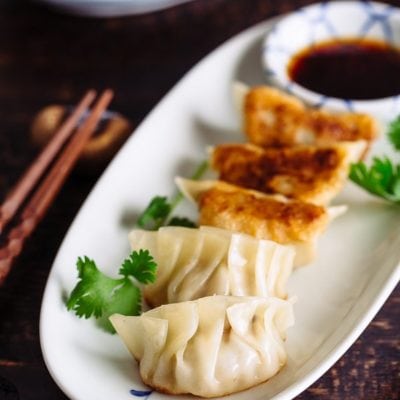
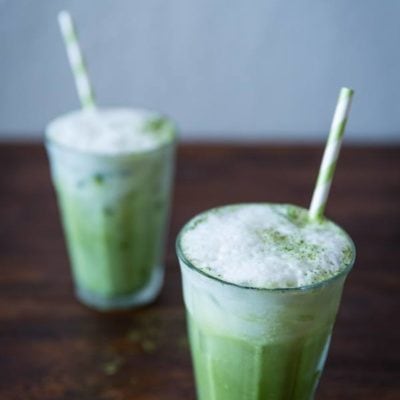

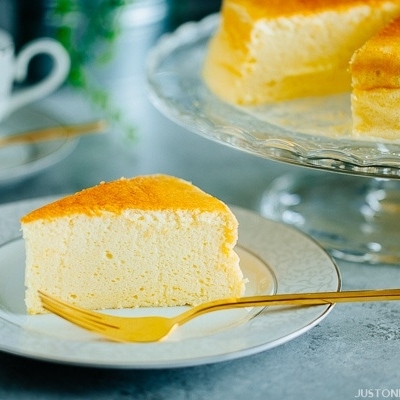
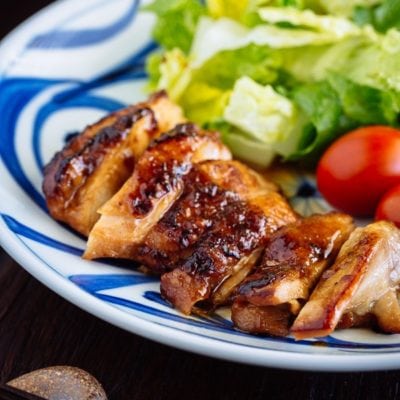
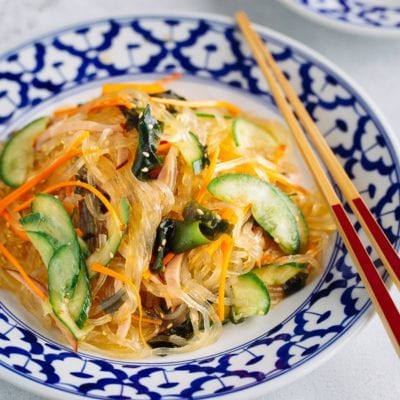
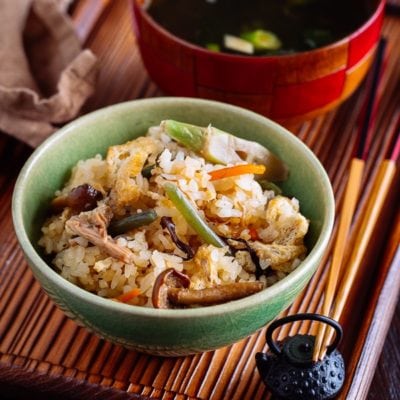
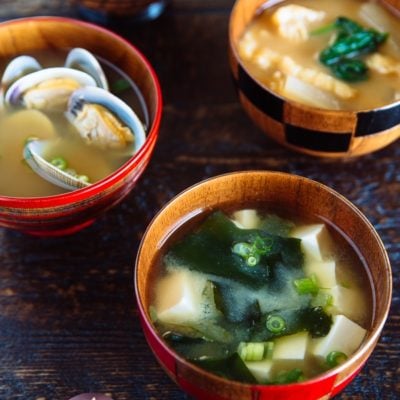

I like this recipe a lot, but 1 tbsp sugar for me is way too much. It completely removed the sharpness of the kimchi and I had to try to mask the sweetness by adding vinegar. I think next time 1 tsp would be enough.
Hi Tayo! Thank you so much for trying this recipe! 🙂 Please feel free to adjust the recipe. My goal for the site is to share the Japanese food that we eat in Japan, trying to replicate foods that travelers enjoyed while traveling, so the taste might not be a perfect fit for everyone. Japanese don’t take spice very well (we don’t really have spicy food), so this kind of Korean style recipes are altered to Japanese taste. 🙂 Glad you found the good adjustment and thanks for sharing it so others can try it! xo
This recipe was so delicious! My partner said it is the best hot pot I have made so far. The flavors were just so yummy. I put in soba noodles at the end to finish up the broth and it made it extra filling.
Hi Mei! I’m so glad to hear you and your partner enjoyed this dish! Thanks for trying this recipe and for your kind feedback. 🙂 It’s a perfect hot pot for a cold winter night!
Hi!
I’m just letting you know that in the recipe page, you accidentally put 4 oz kombu instead of .4 oz! I think it would be a good idea to change that to prevent any confusion. I’m gonna try making this recipe tomorrow!! 🙂
Hi Tye! Oh my goodness! Thank you for noticing my typo! I’ve fixed it. Hope you enjoyed the recipe!
This is an amazing recipe! I had the recipe bookmarked since you posted it and finally made it on a whim. I thoroughly enjoyed the kimchi nabe even though it’s the middle of summer right now. It tastes refreshing and the tangy spiciness is well-balanced with the other ingredients. The first spoonful made me so happy especially because I love all kimchi dishes. I never get disappointed by your recipes. Thank you! 🙂
Hi Yan! Thank you so much for remembering to cook this recipe since I published this post. 🙂 I’m so happy you enjoyed this recipe. Thank you for your kind feedback. It made me happy! 🙂
Hi Nami,
It’s winter here in Australia right now and therefore the perfect time of year for hot pot recipes! I made this for dinner tonight and even though I cheated a bit and used chicken stock rather than make the broth, it was still very tasty and deliciously warming. Even still have some left overs to look forwards to having for lunch tomorrow.
Your site is one of my favourites to come to for recipes so thank you for all the work you put in 🙂
Hi Jeana! I’m so happy to hear you tried this recipe and enjoyed it! Thank you for your feedback and kind words! 🙂 xo
Have made this dish several times and it is really tasty! Have made it both with or without dashi which can be hard to find here in Sweden. We didn’t actually think it added that much and will use chicken/veggie broth next time again.
Hi Anna! I’m so happy to hear you tried this recipe many times. Thank you! Hope you enjoy it with chicken/veggie broth too! 🙂
I made this tonight! A+, absolutely prenominal. I served to a guest who is a native to Japan, and they thought it was 100% authentic. Full disclosure, I have a soy allergy and colitis, so I did not use soy sauce or Miso, instead I substituted vegetable boullion for Miso, and extra kimchee for the soy sauce. I also did not add the hot pepper paste, as my kimchee is already VERY spicy. Will definitely make again!
Also, daikon cubes instead of tofu. Almost forgot!
Hi Sandon! Thank you so much for trying this recipe! I’m so happy to hear you liked it! Thank you for your kind feedback! xo
You are so inspiring me. I really like the way you take time to explain very detail on each recipe. They are so delicious and very well presenting . Love Japanese food so much. You don’t know how much I love your website with all amazing videos. Wish you all the best always.
Hi Tiffany! Aww thank you so much! I was just telling Mr. JOC how much time I spend to write each post…and feel like I am over-spending my hours for it. I often spend days to write a single post (no wonder I can’t publish more frequently…haha). But your comment really encouraged me! Thank you!
Hello Nami-san. I am so sorry to hear about your water heater. I know exactly how you feel, we had to get a new one 2 weeks ago because ours too started to leak. In fact we had to drain our old water heater 3 times before we purchased a new one. I am not looking forward to our water bill this month.
Keep up the great work!! I really enjoy your videos.
Hi Chiyo! Thank you! We got it fixed right before we leave for the trip! We also had to drain the water heater tank too! We were doing that passed midnight. It wasn’t fun. 😀 Thank you for checking my post and video! 🙂
Oh, I’ve been looking forward to this recipe since New Year’s! It has gotten much colder and this is perfect for these cold wintery nights. Thank you for uploading your version! I can’t wait to try it out.
Hi Kari! Thank you so much for waiting. Sorry it took a little longer than expected. With video included in the post, it takes longer to prepare. 😀 Hope you enjoy this recipe and stay warm! 🙂
Wonderful, hearty, flavoursome recipe. It was a hot summer day here, today, but I could still have a bowl of this!
Hi Ivy! I know, I’m sorry I’ve been sharing winter recipes. I always feel bad about sharing “seasonal” recipes with my dearest readers who are in opposite season! Thank you so much for reading my blog.
Thanks for sharing another hot pot recipe.
Could you share a recipe for yuki nabe and ishikari nabe?
Thank you Jessica! I added them to my list. 🙂 Thank you for your request!
What fun working out this Japanese/Korean fusion food 🙂 ! In Australia ‘fusion’ is naturally everyday as we live so close and relate to so many Asian nations! Well, I am kind of relieved your version to be tried does contain onion ’cause I don’t think I would begin most main course dishes sans onion/garlic!!! ‘Iriko’ is new to me – this week’s homework!!!!
Hi Eha! Japanese use iriko dashi for miso soup and other dishes. It’s not as common as katsuobushi and kombu dashi though. Thank you for reading this post, Eha! xo
This looks delicious. I actually have many of the components for this dish already set and ready to combine – I think I am going to put them together for my breakfast this morning!
Hi Rachael! I hope you enjoy this recipe! I’d LOVE to eat this for breakfast too. 🙂
It was DELICIOUS! So, I had on hand: kimchi, dashi I had made for your recent eggplant recipe, shirataki noodles, green onions, cooked beef (sukiyaki cut), enoki, baby bella mushrooms & carrots. I pretty much threw everything in a sauce pot (after grilling the mushrooms separately) heated it up, garnished with chilled kimchi & green onions! It was soul-warming <3
Hi Rachael! So nice! I need to make this again soon! Hearing your story made me crave even more for kimchi nabe. 😀 Thanks so much for trying this recipe! xo
I tend to make this a lot when it’s cold. It’s easy and the ingredients are in my refrigerator on a regular. I heart very spicy food and I want my kimchi very hot. Thanks for sharing. I have found a new way to make the broth. Can’t wait to try it!
Hi Jennifer! Yeah, spicy food on cold days is really nice. Hope you enjoy this recipe! 🙂